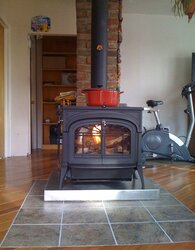I have a platform of 6 half sheets of 1/2" Durock for the new VC Two-in-One Encore, to be used as a pedestal on a 4'x5', Wonderboard-backed tiled hearth. I was considering leaving the top of the Durock unfinished because I kind of like the raw cement look. But then I realized it's too porous and will get filthy with soot quickly.
I really don't want to tile it. I'm fine with a plain surface for this "pedestal." But I want it to be low maintenance, i.e. easy to wipe clean. Keeping it gray, or even making it a darker gray, seems best to make soot less obvious.
Any ideas for a simple way to seal the Durock surface? Would some sort of penetrating sealer work? Or would high temperature paint for cement be best, and if so, what should I be looking for?
I really don't want to tile it. I'm fine with a plain surface for this "pedestal." But I want it to be low maintenance, i.e. easy to wipe clean. Keeping it gray, or even making it a darker gray, seems best to make soot less obvious.
Any ideas for a simple way to seal the Durock surface? Would some sort of penetrating sealer work? Or would high temperature paint for cement be best, and if so, what should I be looking for?



